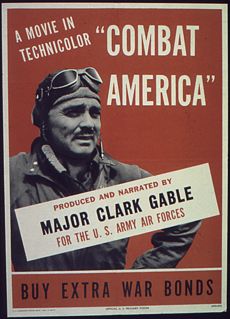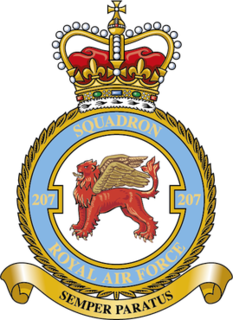
The Avro Anson is a British twin-engined, multi-role aircraft built by the aircraft manufacturer Avro. Large numbers of the type served in a variety of roles for the Royal Air Force (RAF), Fleet Air Arm (FAA), Royal Canadian Air Force (RCAF) and numerous other air forces before, during, and after the Second World War.

No. 7 Squadron of the Royal Air Force operates the Boeing Chinook HC6 from RAF Odiham, Hampshire.

No. 18 Squadron of the Royal Air Force operates the Boeing Chinook from RAF Odiham. Owing to its heritage as a bomber squadron, it is also known as No. 18 (B) Squadron.

Royal Air Force Finningley or RAF Finningley was a Royal Flying Corps and Royal Air Force station at Finningley, in the Metropolitan Borough of Doncaster, South Yorkshire, England. The station straddled the historic county boundaries of both Nottinghamshire and the West Riding of Yorkshire.

633 Squadron is a 1964 British / American war film directed by Walter Grauman and starring Cliff Robertson, George Chakiris, and Maria Perschy. The plot, which involves the exploits of a fictional World War II British bomber squadron, was based on the 1956 novel of the same name by former Royal Air Force officer Frederick E. Smith, which itself drew on several real RAF operations. The film was produced by Cecil F. Ford for the second film of Mirisch Productions UK subsidiary Mirisch Films for United Artists. 633 Squadron was the first aviation film to be shot in colour and Panavision widescreen.

A Yank in the R.A.F. is a 1941 American black-and-white war film directed by Henry King and starring Tyrone Power and Betty Grable. Released three months before the attack on Pearl Harbor plunged the United States into World War II, it is considered a typical early-World War II production. Originally titled The Eagle Squadron, it is based on a story by "Melville Crossman", the pen name for 20th Century Fox studio chief Darryl F. Zanuck. It follows an American pilot who joins the Royal Air Force (RAF), during a period when the United States was still neutral.

The Vickers Varsity is a retired British twin-engined crew trainer operated by the Royal Air Force from 1951 to 1976.

Royal Air Force Barford St John or RAF Barford St John is a Royal Air Force station just north of the village of Barford St. John, Oxfordshire, England. It is now a non-flying facility, operated by the United States Air Force as a communications centre with many large communications aerials, and is a satellite of RAF Croughton.

The Lion Has Wings is a 1939 British, black-and-white, documentary-style, propaganda war film that was directed by Adrian Brunel, Brian Desmond Hurst, Alexander Korda and Michael Powell. The film was produced by London Film Productions and Alexander Korda Film Productions and 'was preparing the nation and shining a light on the power of the RAF'. The Lion Has Wings was made at the outbreak of World War II and was released to cinemas very quickly. It helped convince the British government of film's value for disseminating both propaganda and information.

No. 38 Squadron of the Royal Air Force was a bomber squadron formed in 1916 and was disbanded most recently in 1967.

Target for Tonight is a 1941 British World War II documentary film billed as filmed and acted by the Royal Air Force, all during wartime operations. It was directed by Harry Watt for the Crown Film Unit. The film is about the crew of a Wellington bomber taking part in a bombing mission over Nazi Germany. The film won an honorary Academy Award in 1942 as Best Documentary by the National Board of Review. Despite purporting to be a documentary there are multiple indicators that it is not quite as such: film shots include studio shots taken from the exterior of the aircraft looking into the cockpit whilst "in flight"; several stilted sections of dialogue are clearly scripted; on the ground shots of bombing are done using model trains; and several actors appear. The film does give a unique insight into the confined nature of the Wellington's interior and some of the nuances of day to day operation such as ground crew holding a blanket over the engine while it starts to regulate oxygen intake.

Combat America is a 1945 documentary film produced in World War II, narrated by Clark Gable. At the time of the film's production in 1943, Gable was a 1st Lieutenant in the Eighth Air Force, part of the United States Army Air Forces. While he was stationed in England, Gable flew five combat missions from May 4–September 23, 1943, and during one of them, his boot was struck by an anti-aircraft shell, and he was nearly hit by other flak bursts. Gable's film crew included MGM cameraman Andrew J.McIntyre; 1st Lt. Howard Voss, a sound engineer; Master Sgt. Robert Boles, a cameraman; Master Sgt. Marlin Toti, another cameraman; and 1st Lt. John Mahlin, a scriptwriter."

No. 55 Squadron Royal Air Force, commonly abbreviated 55 Sqn RAF, is a formerly active flying squadron of the Royal Air Force (RAF). It was formed on 27 April 1916, as a unit of the Royal Flying Corps (RFC). No. 55 Squadron was the last RAF squadron to operationally fly the Handley Page Victor, in its Victor K.2 in-flight refuelling air-to-air tanker role. 55 Sqn was subsequently a navigator training squadron based at RAF Cranwell in Lincolnshire. The squadron latterly operated the Hawker Siddeley Dominie, a military version of the HS.125 business jet, until its disbandment in January 2011.

Number 207 Squadron is a historic bomber squadron and, latterly, a communications and flying training squadron of the Royal Air Force. It was announced on 5 July 2017 that No. 207 Squadron will again reform to become the Operational Conversion Unit for the UK F-35B Lightning Force and will return to RAF Marham in Norfolk where it was last based in 1965. No. 207 Squadron arrived at RAF Marham with six F-35Bs on 16 July 2019 before officially standing up on 1 August.

Number 57 Squadron, also known as No. LVII Squadron, is a Royal Air Force flying training squadron, operating the Grob Prefect T1 from RAF Cranwell, Lincolnshire.

Royal Air Force Driffield or RAF Driffield is a former Royal Air Force station in the East Riding of Yorkshire, in England. It lies about 2 miles (3 km) south-west of Driffield and 11 miles (18 km) north-west of Beverley. It is now operated by the Defence Infrastructure Organisation, as the Driffield Training Area.

No. 223 Squadron RAF was a squadron of the Royal Air Force. Originally formed as part of the Royal Naval Air Service (RNAS), the Squadron flew in both World Wars.
Air Vice Marshal Eric Bourne Coulter Betts, was an Irish air officer of the British Royal Air Force. He began his career in the Royal Naval Air Service during the First World War. He became a flying ace credited with six aerial victories, although acedom was incidental to his more important mission of long range photographic reconnaissance, for which he was decorated.

Air Vice Marshal Harold Spencer Kerby, was Canadian-born air officer of the Royal Air Force. He served in the Royal Naval Air Service during the First World War, where he became a flying ace with nine confirmed aerial victories, later transferring to the Royal Air Force, rising to command of British Air Forces in East Africa during the Second World War.

Royal Air Force Film Production Unit produced propaganda films depicting RAF personnel and aircraft both on the ground and in aerial action during World War II from 1941 to 1945.



















